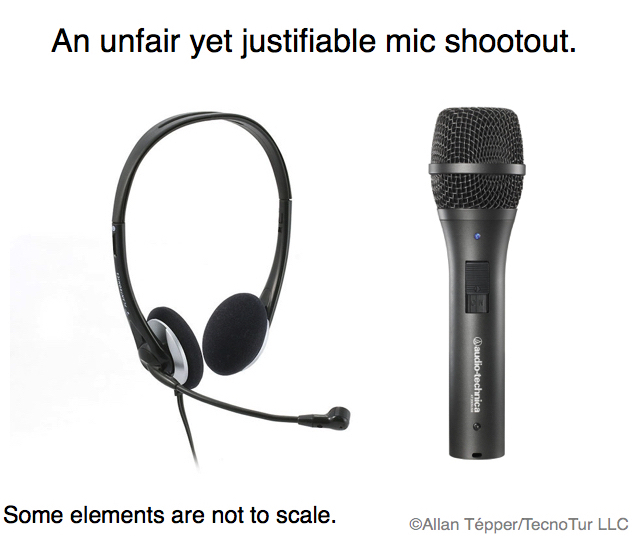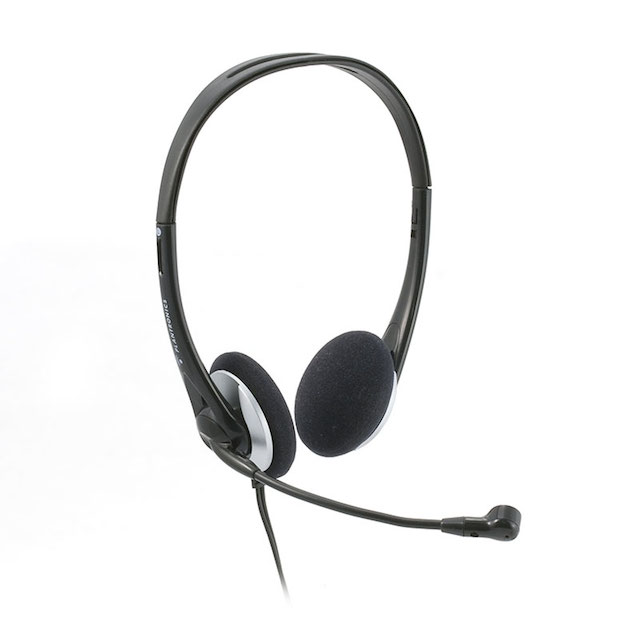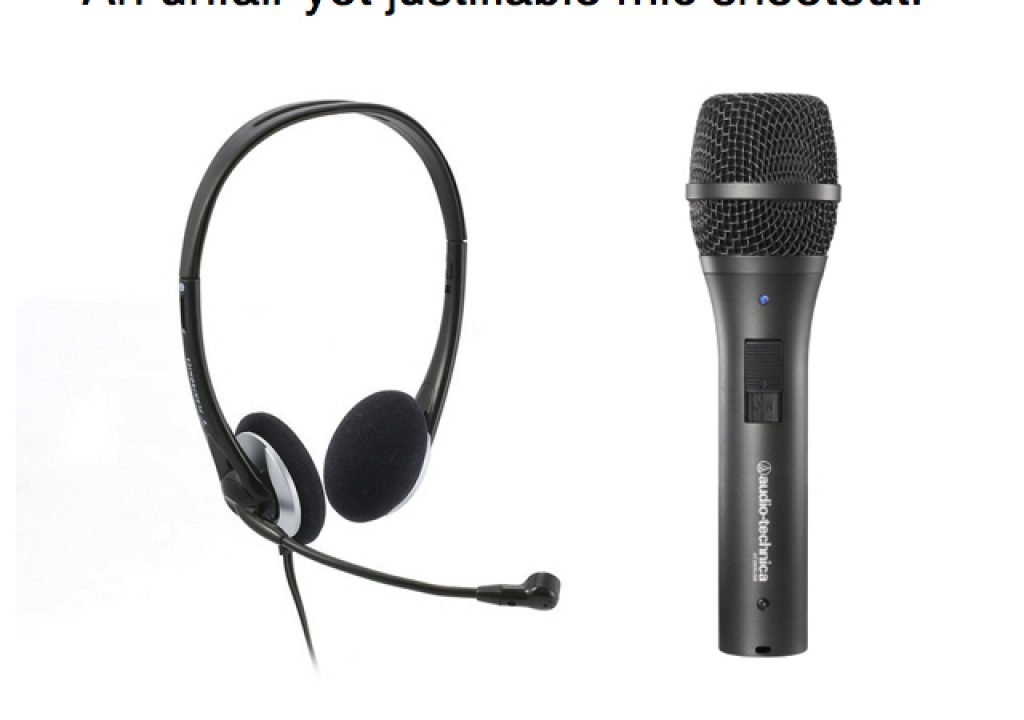
I have covered the Audio Technica AT2005USB hybrid microphone (analog XLR + digital USB) in past articles and ebooks, and it has been my chosen studio microphone for my recent podcasts. On the other hand, I recently reviewed the Plantronics .Audio 326 headset microphone with outstanding results. Now, even though it might be considered unfair, I am doing a direct shootout. Ahead are my justifications and test results, including simultaneous recordings through each mic.
In this article
- Plantronics .Audio 326 headset mic
- Audio Technica AT2005USB dynamic hybrid microphone
- Why compare a handheld mic to a headset mic?
- Simultaneous recordings, and how I made them
- Conclusions
Plantronics .Audio 326 headset mic

Back in September 2014, I reviewed the sub-US$15 Plantronics .Audio 326 (here is that review, including recordings). As I stated in that review, I found the Plantronics .Audio 326 after looking for an analog microphone/headset to use for applications when the camera operator needs to be the interviewer too, and needs to monitor the signal as it’s being recorded. The idea is that the camera operator/interviewer’s voice is to be recorded on one audio channel, and the interviewee on another, in dual mono. Many of our readers/listeners and I were astounded by the voice quality achieved with this inexpensive headset when used with a good preamp and A>D (analog to digital) converter. That article was followed by a subsequent one about that converter I used, Review: Tascam iXJ2 preamp/A>D enables dual-mic/2-channel opportunities for iOS mediography.
Although with those two articles, I used the Plantronics .Audio 326 with an iOS device (iPad/iPhone/iPod Touch)
using the Tascam iXJ2, for today’s microphone comparison and some upcoming review articles (including new recorder and cameras), I used no iOS devices at all. Instead, I used the Plantronics .Audio 326 with a brand new portable audio recorder (that I’ll be reviewing soon) which fortunately has both a direct matching connector for the Plantronics .Audio 326’s microphone plug (3.5 mm TRS with optional bias voltage, aka plugin power, which is similar but not the same thing as phantom power), as well as two XLR balanced inputs which accept the signal from professional balanced microphones like the AT2005USB. (The recorder also offers optional phantom power on the XLR inputs, but they are not required —or desired— with the AT2005USB, since it’s dynamic.) One last detail about the recorder: It has a new and higher gain preamp than its predecessor from the same manufacturer, so there is plenty of headroom in it.
Audio Technica AT2005USB dynamic hybrid microphone
This microphone is still one of my favorites when you need the benefits of a dynamic mic, sometimes need analog output (XLR balanced), and at other times need digital output (USB). That’s why I continue to use multiple AT2005USB microphones for in-studio podcasting, as well as for some field work. Here are some of the many articles and ebooks where I have covered it.
- 1st handheld dynamic microphones with hybrid XLR/USB/iPad connectivity from Audio Technica from April 2012
- Part 2: Hybrid XLR/USB/iPad mics that rival expensive studio mics from June 2012
- [Record audio at 48 kHz on an iPad from a digital source? Yes!](Record audio at 48 kHz on an iPad from a digital source? Yes!) (from June 2012)
- ebook: Hybrid USB/XLR microphones: the missing workflow for independent voice talent & podcasters from June 2012
- libro-e: Micrófonos híbridos USB/XLR: el flujo de trabajo faltante para locutores y podifusores independientes de junio del 2012
Why compare a handheld mic to a headset mic?
Mainly, I was quite curious to determine how different the two microphones would sound to intercut with voiceover studio recordings made with the AT2005USB… or —if it sounds very good, but very different— whether to consider using the Plantronics .Audio 326 for in studio narration to make it match better. If that were the case, then it would also have the other benefits of a headset mic, i.e. absolute consistent distance from the mouth, and the lack of requirement for studio hardware mounting, together with complete freedom of movement for the person speaking.
Simultaneous recordings, and how I made them
Here are the simultaneous recordings and how I made them.
AT2005USB
Plantronics .Audio 326
The AT2005USB hybrid microphone was already mounted onto the PL–2T flexible boom from Heil, with a pop filter. I plugged the Plantronics .Audio 326’s 3.5 mm TRS (tip/ring/sleeve) microphone plug into the portable audio recorder’s 3.5 mm TRS mic input. Since the Plantronics .Audio 326 requires bias voltage (aka plugin power), which —as stated in prior articles— is similar, but not the same as phantom power, I activated plugin power on the recorder for that input. I plugged the Plantronics .Audio 326’s 3.5 mm TRS stereo headphone plug into the portable recorder’s headphone output for live monitoring. I plugged the AT2005USB microphone’s balanced analog XLR output to one of the XLR inputs on the portable recorder. Since the AT2005USB is dynamic, I did not activate phantom power on the recorder. I set the portable audio recorder for four-channel recording (that’s the only way to access the 3.5 mm input and the XLR inputs simultaneously). Since 48 kHz is the absolute standard for digital audio for digital video, I set the audio recorder to record 48 kHz/24-bit. I set a good audio level for each of the mic inputs I used, and recorded. The recorder creates two separate uncompressed WAVE files: a “stereo” file from the 3.5 mm input, plus a “stereo” file from the XLR inputs. Considering that the Plantronics .Audio 326’s output is TRS fake stereo (dual mono with identical information on each channel), the same exact signal is recorded on the Left and Right channels of the recording from the 3.5 mm TRS input of the recorder. The other “stereo” file recorded naturally has one silent channel, plus the channel where I had the AT2005USB connected.
I opened each file individually in Amadeus Pro (which I covered recently in Amadeus Pro, Audio Hijack, Sole Giménez and CapicúaFM), eliminated the silent or unnecessary channel, normalized, trimmed, normalized again and saved the now mono uncompressed 48 kHz WAVE files for upload to SoundCloud. (I used no equalization.) SoundCloud automatically encoded them to MP3 for streaming, and you do have the option of downloading the original uncompressed WAVE files.
Conclusions
Feel free to comment below as to how they each sound to you. I found them to be quite similar, which opens up a world of possibilities for combinations of mics in the field and in post.
Upcoming articles, reviews, and books
Stand by for upcoming articles, reviews (including the audio recorder used in this article, and new cameras from Panasonic and Sony), and books. Sign up to my free mailing list by clicking here.
Si deseas suscribirte a mi lista en castellano, visita aquí. Si prefieres, puedes suscribirte a ambas listas (castellano e inglés).
Books, consulting, articles, seminars & audio programs
My latest book (paperback + ebook)
My most recent book is available in two languages, and in paperback as well as an ebook. The ebook format is Kindle, but even if you don’t have a Kindle device, you can read Kindle books on many other devices using a free Kindle app. That includes iPad, Android tablets, Mac computers, and Windows computers. Although generally speaking, Kindle books are readable on smartphones like Androids and iPhones, I don’t recommend it for this particular book since it contains both color photos and color comparison charts. The ebook is also DRM-free.
In English:
In English, it is currently available in the following Amazon stores, depending upon your region:
- Amazon.com, for the US and other countries in the Americas that don’t currently have their own Amazon store, or anywhere if you simply prefer it
- Amazon.br for Brazil
- Amazon.ca for Canada
- Amazon.de for Germany
- Amazon.es for Spain pero a lo mejor lo preferirás en castellano, a continuación)
- Amazon.fr for France
- Amazon.in for India
- Amazon.it for Italy
- Amazon.co.jp for Japan
- Amazon.com.mx for México
- Amazon.co.uk for the United Kingdom
Or in your favorite bookstore by requesting ISBN–10: 1456310232 or ISBN–13: 978–1456310233.
En castellano:
En castellano, está disponible actualmente en las siguientes tiendas Amazon, según tu región:
- Amazon.com para EE.UU. y todas las Américas donde no existe ninguna tienda particular… o en cualquier parte si simplemente lo prefieres
- Amazon.com.br para Brasil
- Amazon.co.jp para Japón
- Amazon.de para Alemania
- Amazon.es para España
- Amazon.fr (Francia)
- Amazon.in para India
- Amazon.it para Italia
- Amazon.com.mx para México
- Amazon.co.uk para el Reino Unido
o en tu librería preferida al solicitar el ISBN–10: 1492783390 ó el ISBN–13: 978–1492783398.
FTC disclosure
No manufacturer is specifically paying Allan Tépper or TecnoTur LLC to write this article or the mentioned books. Some of the other manufacturers listed above have contracted Tépper and/or TecnoTur LLC to carry out consulting and/or translations/localizations/transcreations. Many of the manufacturers listed above have sent Allan Tépper review units. So far, none of the manufacturers listed above is/are sponsors of the TecnoTur programs, although they are welcome to do so, and some are, may be (or may have been) sponsors of ProVideo Coalition magazine. Some links to third parties listed in this article and/or on this web page may indirectly benefit TecnoTur LLC via affiliate programs.
Copyright and use of this article
The articles contained in the TecnoTur channel in ProVideo Coalition magazine are copyright Allan Tépper/TecnoTur LLC, except where otherwise attributed. Unauthorized use is prohibited without prior approval, except for short quotes which link back to this page, which are encouraged!


